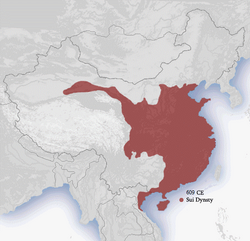Sui dynasty
Sui Chinese: 隋 | |||||||||
|---|---|---|---|---|---|---|---|---|---|
| 581–618 | |||||||||
 Sui dynasty c. 609 | |||||||||
| Capital | Daxing (581–605), Luoyang (605–618) | ||||||||
| Common languages | Middle Chinese | ||||||||
| Religion | Buddhism, Taoism, Confucianism, Chinese folk religion, Zoroastrianism | ||||||||
| Government | Monarchy | ||||||||
| List of emperors of China | |||||||||
• 581–604 | Emperor Wen | ||||||||
• 604–617 | Emperor Yang | ||||||||
• 617–618 | Emperor Gong | ||||||||
| Historical era | Post-classical era | ||||||||
• Ascension of Yang Jian | 4 March 581 | ||||||||
• Abolished by Li Yuan | 23 May 618 | ||||||||
| Area | |||||||||
| 589[1] | 3,000,000 km2 (1,200,000 sq mi) | ||||||||
| |||||||||
| Today part of | |||||||||
The Sui Dynasty ([swěi], Chinese: 隋朝; pinyin: Suí cháo) was an imperial dynasty of China between the years 581 and 618. It followed the "Jin period" and was followed by the Tang Dynasty. It ended nearly four centuries of division between rival regimes.
The Sui Dynasty was founded by Emperor Wen, or Yang Jian. Its capital was Chang'an (present-day Xi'an). The dynasty is important because it reunited Southern and Northern China and the Grand Canal was built in that time.
Related pages[change | change source]
References[change | change source]
- ↑ Taagepera, Rein (1979). "Size and Duration of Empires: Growth-Decline Curves, 600 B.C. to 600 A.D". Social Science History. 3 (3/4): 129. doi:10.2307/1170959. JSTOR 1170959.
Other websites[change | change source]
Wikimedia Commons has media related to Sui Dynasty.
- Sui Dynasty at mnsu.edu Archived 2007-08-10 at the Wayback Machine
